GRG News for 2013
"Prof. Eric R. Kandel, M.D. Lectures at UCLA"
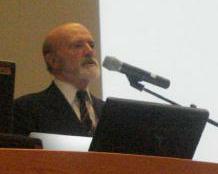
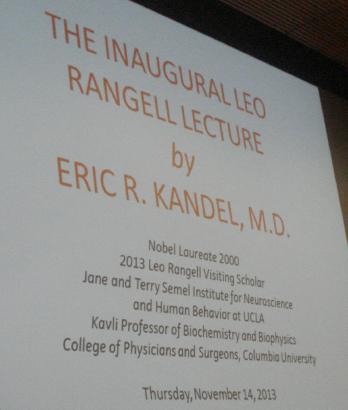
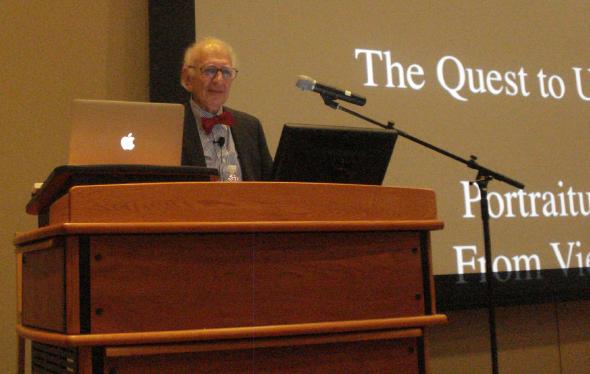
Thursday, November 14, 2013; [4:00 - 6:30] PM; Prof. Peter C. Whybrow, M.D., Director of the
Semel Institute introduced Prof. Eric R. Kandel, M.D., Nobel Prize in Physiology or Medicine in
2000 for his work in memory-encoding in the brain, author of several textbooks, and Kavli
Professor of Biochemistry and Biophysics at Columbia University's College of Physicians and
Surgeons, was the inaugural Leo Rangell Visiting Scholar for 2013 based on an endowment
made possible by Lynda and Stewart Resnick to the Jane and Terry Semel Institute for
Neuroscience and Human Behavior at UCLA to an audience of over 600 persons in the brand
new Palisades Ballroom of Carnesale Commons (Prof. of Physics Albert Carnesale was a former
Chancellor at UCLA). Kandel was born in 1929 in Vienna and came to the US at age 9. His title
was "The Age of Insight: The Quest to Understand the Unconscious in Art, Mind, and Brain
from Vienna 1900 to the Present Day." He surprised the audience with a number of common
optical illusions, the obscure fact that there are six distinctly-separated areas of the monkey brain
involved in face recognition (even cartoons of faces) within temporal/parietal regions and that
these regions are highly interconnected, and finally that so called mirror neurons light up
motor areas in the brain of someone watching someone else carry out motor actions in the real
world, like walking or picking up an object. The level of dopamine rises significantly in the
brain when you are shown a photo of a loved one, but it goes off-the-scale when you are rejected
by your significant other. The lecture was followed by a reception in which Dr. Kandel
graciously answered questions from all parties.
"PSR-LA Meets with Sen. Feinstein and Sen. Boxer's Staff"


Thursday, November 7, 2013; [10:45 AM - 3:30 PM]; Ms. Rebecca Griffen, Political Director of
Peace Action West of Oakland, CA, Ms. Farideh Kioumehr-Dadsetan, President of the
International Health and Epidemiology Research Center of Sherman Oaks, CA, Dr. L. Stephen
Coles, Director of Physicians for Social Responsibility - LA in Los Angeles, CA, and Rick
Wayman, Director for the Abolition of Nuclear Weapons and the Nuclear Age Peace Foundation
of Santa Barbara, CA met with Mr. Trevor Daley, State Director of US Sen. Dianne Feinstein's
Staff in the morning (Santa Monica Blvd. in West Los Angeles) and Mr. Rafi Nazarians, Senior
Field Representative of US Sen. Barbara Boxer in the afternoon (downtown LA in the top floor
of Federal Court House on North Spring Street) regarding the proposed refurbishment of our
stockpile of ~500 B61 Nuclear Weapons based in Europe (B61 Life Extension Program [B61
LEP]) [US$12 billion] and the W78/88-1 Interoperable Warhead (joint USAF and
Navy)[US$[12-13] Billion] project as well as the issue of conducting diplomacy over
newly-proposed economic sanctions on the government of Iran despite the desire of the new
Iranian President Hassan Rouhani to come to an agreement with the West about their
nuclear-energy program and its potential for building dangerous weapons of mass destruction.
"15th Clinical Applications for Age Management
Medicine Conference"
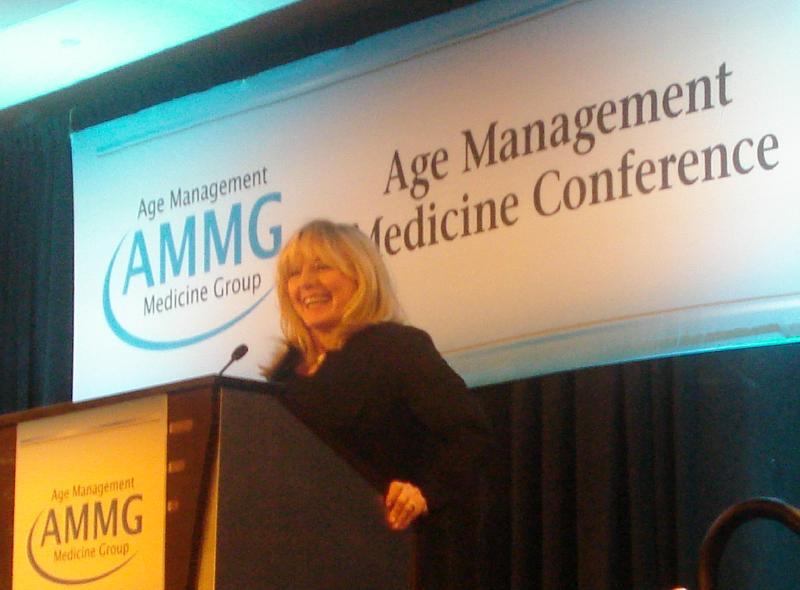
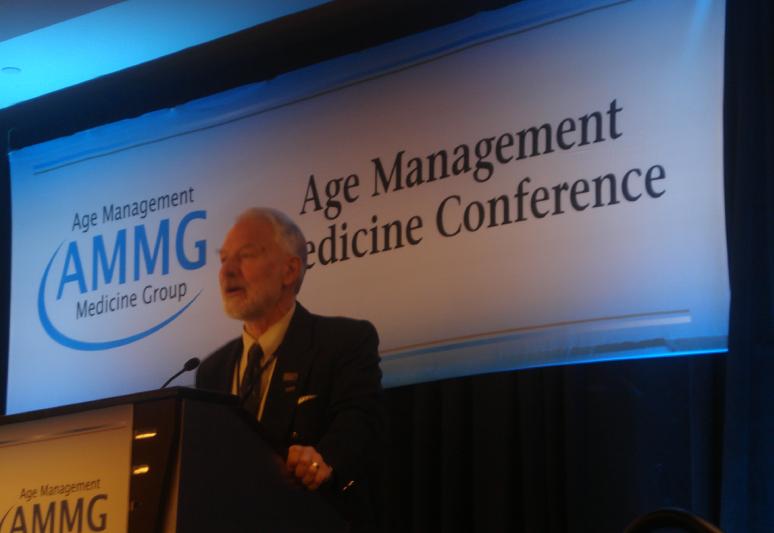
Friday,
November 1, 2013; [8;05 - 8:30] AM and [11:15 AM - Noon] PDT; Cosmopolitan Hotel in Las
Vegas, NV. Dr. Florence Comte, M.D. received the 2013 Alan P. Mintz Award for Clinical
Excellence in Age Management Medicine. Dr. Coles gave the keynote address on Clinical
Genomics for Age Management Medicine. There were 500 Registrants, 36 Faculty Members,
and 55 Exhibitors.
"Prof. Joel Buxbaum Gives Lecture at UCLA"
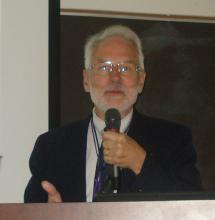
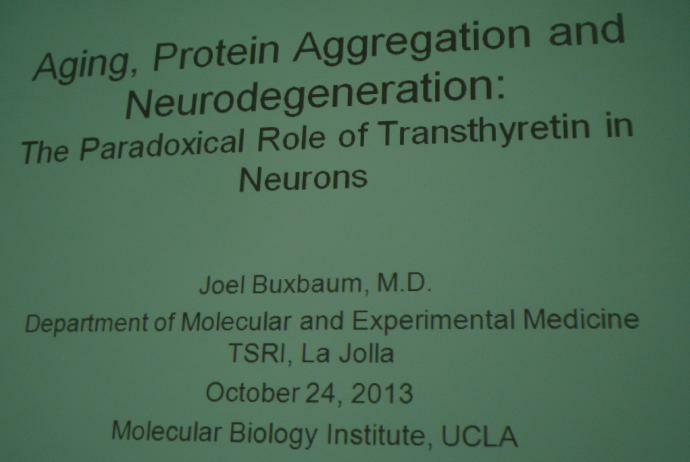

Thursday,
October 24, 2013; 4:00 PM; Prof. Joel Buxbaum, M.D. (R) of the Scripps Research Institute in
La Jolla, CA gave a lecture on the topic of "Aging, Protein Aggregation, and Neurodegeneraton:
On the Paradoxical Effect of TTR (Transthyretin) on Neurons and Alzheimer's Disease" to ~50
attendees at the UCLA Molecular Biology Institute. He was introduced by Dr. Stephen Coles (L)
who hosted him for the day.
"2013 Nobel Prize in Physiology or Medicine"
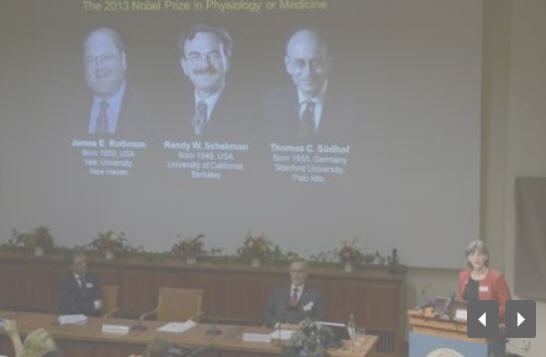
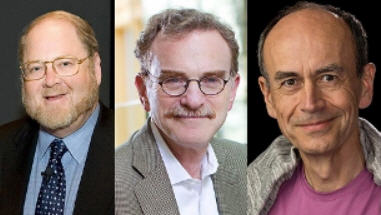
Work on 'cell traffic' and disease triggers wins Nobel prize; Juleen Zierath (R), Chairman of
the Nobel Committee for Medicine or Physiology, speaks during the announcement of the
winners of the 2013 Nobel Prize for Medicine or Physiology at the Nobel Assembly at the
Karolinska Institute in Stockholm October 7, 2013. A portrait of U.S. scientist James Rothman
and drafts of his work are displayed on a screen during a news conference at the Nobel Assembly
at the Karolinska Institute in Stockholm.
Monday, October 7, 2013; Reuters - Janerik Henriksson - TT News
Agency; Randy Schekman, a Professor at the University of California, Berkeley, smiles in
this undated handout picture provided by the university on October 7, 2013. REUTERS-Peg
Skorpinski University of California, Berkeley Handout via Reuters.
by
Niklas Pollard
Stockholm, SWEDEN (Reuters) - - Three U.S.-based scientists won the Nobel
medicine prize on Monday for plotting how vital materials such as hormones and brain chemicals
are transported within cells and secreted to act on the body, giving insight into diseases such as
diabetes and Alzheimer's. Americans James Rothman, 62, Randy Schekman, 64, and
German-born Thomas Südhof, 57, separately mapped out one of the body's critical
networks that uses tiny bubbles known as vesicles to ferry chemicals such as insulin within
cells.
The system, which also describes how vesicles transport molecules to the cell surface for
secretion, is so critical and sensitive that errors and disruption in the mechanism can lead to
serious illness or death.
"Without this wonderfully precise organization, the cell would lapse into chaos," the Nobel
Assembly at Sweden's Karolinska Institute said in a statement when awarding the prize of 8
million crowns (US$1.2 million).
"Through their discoveries, Rothman, Schekman and Südhof have revealed the
exquisitely precise control system for the transport and delivery of cellular cargo." For example,
their research sheds light on how insulin, which controls blood sugar levels, is manufactured and
released into the blood at the right place at the right time, the Nobel Committee said in the
statement. Diabetes and some brain disorders have been attributed at least in part to defects in
the vesicle transport systems.
Rothman is Professor at Yale University, Schekman is a Professor at the University of
California at Berkeley, while Südhof is a Professor at Stanford University. The three,
working separately, adopted quite different approaches to the problem, reflecting their own
scientific specialties.
"How Cells Work"
"My first reaction was, "Oh, my god!" said Schekman, who was woken with the good news
in the early hours of his morning. "That was also my second reaction," he added, according to a
Berkeley University statement.
Suedhof, a U.S. citizen, professed similar surprise. "It blew me over," he told
Reuters. "Every scientist dreams of getting a Nobel prize. It's something I often tell my kids.
If you lose your dreams you lose your reason to live."
Medicine is the first of the Nobel prizes awarded each year. Prizes for achievements in
science, literature, and peace were first awarded in 1901 in accordance with the will of dynamite
inventor and businessman Alfred Nobel.
Südhof said the work was really about "cell traffic," the ability of cells to move
material around. "We have met each other many many times and argued and sometimes agreed
and sometimes disagreed," he said of his fellow prize winners. "We really work in quite distinct
areas of science."
Prof. Patrik Rorsman of Oxford University said the award was timely and well deserved. "It
is such a fundamental process they have studied and explained. Their discoveries could perhaps
have clinical implications in psychiatric diseases, but my guess is that they will be more useful
for the understanding of how cells work."
The committee said the work could help in understanding immuno-deficiency, as well as
brain disorders, such as autism.
Schekman, a geneticist, first became interested in how proteins move within cells in 1974.
At the University of California, Berkeley, he began working on yeast, a single cell
microorganism. Research showed his findings applied equally to human cells. Among
Schekman's research aims is to study whether the accumulation of the protein amyloid in the
brains of Alzheimer's Disease patients is due to disruption of the vesicle system.
Südhof, a Neuroscientist, has focused particularly on the brain and questions of
human thought and perception, emotions and actions determined by signaling between neurons,
cells which constitute the foundation of the nervous system. "I'm interested in understanding
how is it possible for one cell to talk to another ... This field is one of the most fundamental
fields involved in understanding how the brain works, which is one of the most important
questions in biology today."
Jeremy M. Berg, Director of the Institute for Personalized Medicine at the University of
Pittsburgh, said the research had tackled key questions of how molecules are directed by vesicles
to the cell wall and secreted to act on the body. "You can't understand anything about how the
brain works without understanding this process. You can't understand anything about hormone
secretion without understanding this process.
"It's one of the prizes for which there is not a treatment that came out of it directly, but there
are probably literally thousands of laboratories around the world whose work would not be taking
place the way it is without their work."
"What Was Prometheus Thinking?"
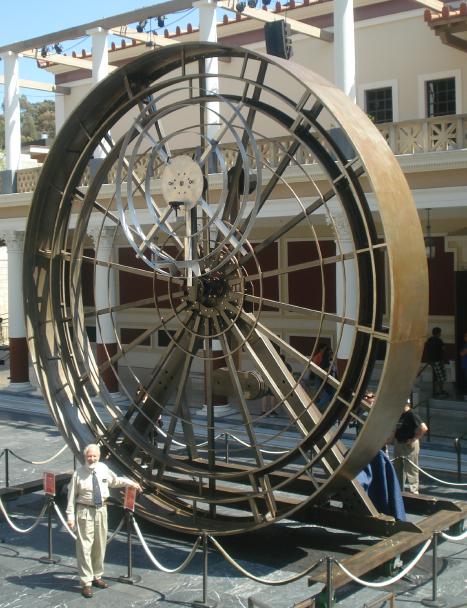

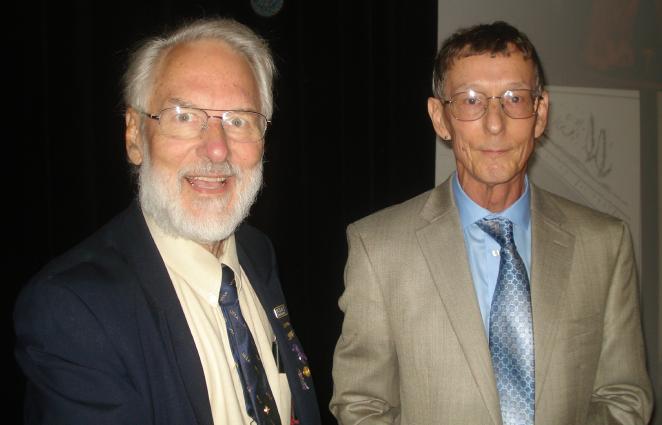
Saturday, September 21, 2013; 2:00 PM PDT; Prof. Mark Griffith of the Classics Department at
UC Berkeley received his Ph.D. in Greek and Latin Literature from Cambridge, UK and gave a
lecture to a full auditorium of ~100 persons on "Defying Zeus To Help Humans: What Was
Promtheus Thinking?" at the Getty Villa located in Malibu, CA.
According to the myth, when Prometheus (a Titan who used logic to anticipate the consequences
of his actions) stole fire from the gods on Mount Olympus and provided it to humans as a gift. In
retaliation, Zeus punished him eternally by impaling him through the rectum, channing him to
rock, and sending an eagle to eat his liver every day (while it grew back every night). This myth
is documented in the play by Aeschylus called " Prometheus Bound" (part of a trilogy), as
it was presumably performed in Athens, GREECE c. 425 BCE (a democracy even before
Socrates, Plato, Aristotle, and Alexander the Great). Prometheus tells the Chorus that he not
only gave humans fire but also taught men many of the civilizing arts, including writing,
medicine, mathematics, astronomy, metallurgy, architecture, and agriculture, so we have to guess
that he must have liked us. But Zeus is again angered when Heracles releases Prometheus from
his torment ~300 years later, and after an argument ensues in which Prometheus refuses to reveal
the name of one of Zeus's rivals, Zeus strikes him dead with a thunderbolt and plunges his body
into an abyss. (Sigh!)
And what about Epimetheus, a Titan brother of Prometheus (who was a rationalizer and who
only had excuses after the fact [his name means "after thought" while his brother's name means
"fore thought"])? As another punishment, Zeus ordered the creation of Pandora, the first
woman, as a means to deliver evil into the the domain of men. Despite the warnings of his
brother, Epimetheus happily received her as his bride, but as soon as she arrived she lifted the lid
of a jar entrusted to her by the gods, releasing a plague of harmful demons (spirits) upon
mankind. Our only hope, Elpis, remained behind to facilitate the continuation of our unfortunate
mortal race that otherwise would have been extinguished.
The Judeo/Christian/Islamic creation story in Genesis (Chapter 2) in which Adam and
Eve are punished by being expelled from the Garden of Eden, has similarities (like defying God
and then being punished), but discovering how to make clothing clearly doesn't have the same
technological significance as discovering how to make a fire - - not only to keep warm but to
cook meat. Why isn't the story of "fire" written into the Old Testament along with other
"just so" stories like "The Tower of Babel" to explain why there are different spoken languages
or "The Flood," in which God allegedly created a rainbow just as a message after a rain for us to
appreciate that He will keep His promises? Privately, Prof. Griffiths speculated that the Israelis
had political reasons for not including the creation myths of their adversaries in their version of
creation, lest their children credit their rivals with greater intelligence than their own parents
(Hebrew tribes vs. their rivals). Of course, the two different creation myths written down in
Genesis are never reconciled and both probably date back to an oral tradition that may have
been told as stories thousands of years before. One can imagine that there were arguments about
which version of creation ("Seven Days" vs. "The Garden of Eden") should be included in the
written (sacred) text, so they included both of them as a compromise without giving special
treatment (priority) to one or the other.
" CNN-TV Interview on a Bolivian Man's
Exaggerated Claim To Be 123 yo"
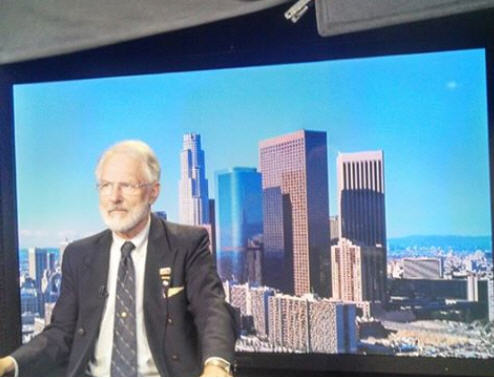
Wednesday, August 21, 2013; [9:49 - 9:55]
AM PDT; Click on the photo for the
CNN-TV Interview (TRT = 6 min. edited down to 2:30 min.) of Dr. Stephen Coles by
Mr. Rafael Romo, Senior Editor of CNN in Atlanta, GA on the exaggerated claim of
Mr. Carmelo Flores Laura from the high Andes Mountains of BOLIVIA, alleged by
family and Bolivian government officials to be the world's oldest person [living or dead] at age
123 yo, exceeding the Guinness Longevity record of French women Madam
Jeanne-Louise Calment, who died in 1997 at the validated age of 122 yo. No one has come
close to her extreme age in the last 16 years, and it is unlikely to happen that another
supercentenarian will exceed this record in our lifetimes. This is why we call the limit of 125 +/-
3 years the maximum human potential lifespan by the name The Calment Limit, a limit
that appears to be encoded in the human genome (3.1 GBP's [Giga Base Pairs] of DNA), since
extreme longevity is now known to be inherited, even though any of us could be struck by
lightning or hit by a truck while crossing the street, and this limit is regardless of one's normal
lifestyle (smoking, drinking alcohol, gender, race, geographical location, occupation, religion,
diet, exercise program, etc.), despite the fact that the human population is increasing
exponentially [the base of the pyramid] and that average life expectancy in all developed
countries has systematically increased in a linear fashion for many decades (filling out the
volume of the apex of the pyramid, and thereby increasing the number of healthy centenarian
individuals in the pool who could potentially exceed the Calment Limit).
US life expectancy in the year 1900 was only 49 yo, while today in the year 2013, it's 78 yo - - a
more than 50 percent increase. We know the reasons why the Top-Ten Diagnoses for Causes of
Death (on Autopsy) in the US have shifted for the last century from childhood infections (due to
the discovery of vaccines), bacterial epidemics (due to the discovery antibiotics coupled with
hygienic public-health measures for separating chlorinated/fluorinated drinking water from
sewage), and obstetrical complications (due to the availability of C-Sections based on surgical
sterile-technique under general anesthesia as well as an understanding of the "ABO"
RBC-antigen system for type-and-cross-matched blood transfusions, which didn't come into its
own until after WW-I) to be replaced with chronic conditions, like heart disease, cancer, stroke,
COPD, diabetes, and Alzheimer's Disease, for which there are few "silver bullets." Interventions
in the aging process itself are the most likely means to provide further advances in actuarial,
population-mortality statistics, rather than trying to cure one disease at a time, now that all the
"low-hanging fruit" has been exploited. However, there is no current agreement among
biogerontologists about how to do this. They're all like the proverbial blind men touching the
elephant each with his or her own understanding of how to solve the problem and, of course,
each asking for funding to follow their personal agenda.
In the mean time, we must remain skeptical about claims of extreme longevity that magically
appear in illiterate populations without proper documentation, despite the wishful thinking of
home boosters for their local areas with access to newspapers and TV stations that have access to
the Internet that now are able to get our attention. See the WWW.GRG.ORG
Supercentenarian Section on the left index, for Incomplete or Fraudulent Claims for
more details about Longevity Myths that fall in the same category as "The Lock Ness
Monster," where demographers were not present to contradict claims of extreme old age in
hard-to-travel-to locations with seductive, romantic-sounding names like Shangri La.
"Aging and Longevity Demographics in Central
America"
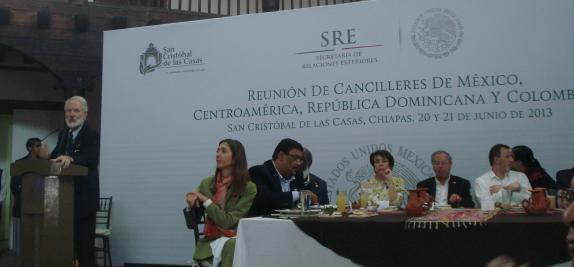

Friday, June 21, 2013 [1:45 - 2:10] PM CDT; Dr. Stephen Coles gave a lunch-time talk on
supercentenarians and the demographics of aging to ~50 Delegates and Ministers of Mexico,
Central America, the Dominican Republic, and Colombia at their one-day conference in San
Cristobal de las Casas, the historic capital of the Mexican State of Chiapas (in the highlands
South of Mexico City and not too far from Guatemala).
Professor John Gurdon

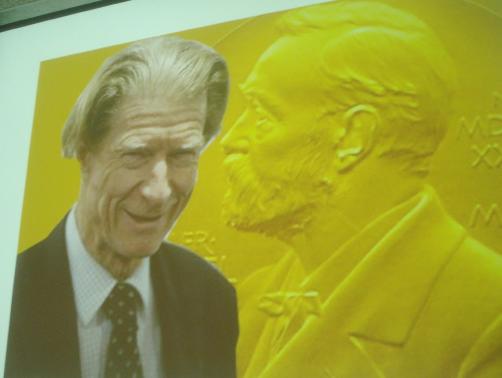
Friday, May 17, 2013; 4:00 PM; Sir John Gurdon, 79, of Cambridge, University; UK,
Nobel Prize in Physiology or Medicine in 2012 for work in embryology that he did while at
Oxford University, lectured to a Special UCLA Embryology Club on "Nuclear Reprogramming
in Oocytes" hosted by Prof. Eddy De Robertis.
"Oregon Health Sciences Uses Cloning for hESC's"
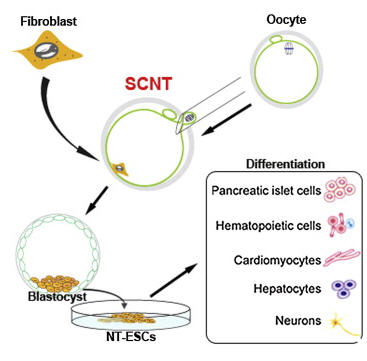

May 16, 2013; Portland, OR (Oregon Health Sciences University) - - As published in the
journal Cell [1], Dr. Shoukhrat Mitalipov, Ph.D. and his team of 23 scientists at OHSU
have taken us one-step closer to the therapeutic cloning of human stem cells [2, 4, 5] using the
same technique that Dr. Ian Wilmut used to bring us Dolly, the Sheep in 1996; it's called
Somatic Cell Nuclear Transfer (SCNT). BTW, the human cloning work was funded by
a French Foundation and not by NIH, which did fund Mitalipov's earlier cloning work with
monkeys. This is only worthy of mention in the context of the bioethical and legal controversy
regarding the presumed destruction of human embryos and the position of the Roman Catholic
Church/HolySee/Vatican/Pope(s) on this matter [3].
Prof. Irving Weissman, M.D. of Stanford University said "The new results are extremely
important." Dr. Robert Lanza, M.D., CSO of Advanced Cell Technology (ACT), called the work
"... a major scientific achievement." Due to the uncertainty regarding iPSC technology and the
potential for tumor-formation/immune-rejection, "SCNT may be the only way to truly reprogram
cells [for autologous therapeutic purposes]." Dr. José Cibelli, Ph.D. of Michigan State
University said, "It will only be a matter of time before this work will be tested therapeutically in
monkeys." Dr. Michael D. West, Ph.D., said that "One of the tricks described in the paper is to
use caffeine [to slow the tendency of human egg cells in culture to begin mitotic
divisions prematurely that apparently doomed prior efforts with human cells], the Starbucks
Effect!"
There were a significant number of complaints by subsequent critics about the figures
(redundancy) and the figure-captions that went with the paper but nothing that would invalidate
the work or require a retraction. The take-home lesson for all of us is that landmark papers like
this one should not be rushed into print or posted on-line before they are fully vetted by
reviewers, since many readers will be rigorously scrutinizing the paper, even if they were not
direct competitors located at other labs.
Refs.:
1. Masahito Tachibana, Paula Amato, Michelle Sparman, Nuria Marti Gutierrez, Rebecca
Tippner-Hedges, Hong Ma, Eunju Kang, Alimujiang Fulati, Hyo-Sang Lee, Hathaitip
Sritanaudomchai, Keith Masterson, Janine Larson, Deborah Eaton, Karen Sadler-Fredd, David
Battaglia, David Lee, Diana Wu, Jeffrey Jensen, Phillip Patton, Sumita Gokhale, Richard L.
Stouffer, Don Wolf, and Shoukhrat Mitalipov, "Human Embryonic Stem Cells Derived by
Somatic Cell Nuclear Transfer," Cell, Vol. 153, No. 6, pp. 1228-38 (May 15, 2013)
Click for the paper at
cell.com.
Click for a video at YouTube
. From the video, it looks easy, and one doesn't get a feeling for how difficult manual
dexterity, technical skill, and extensive experience must be in carrying out the task of puncturing
the oocyte membrane and driving a nucleus (from a skin-cell punch biopsy [with emulsified cells
separated] into the enucleated oocyte cytoplasm and then using a "secret sauce" of chemical
cytokines for nutrition and one or more jolts of a small DC electric current to trigger the onset of
mitotic divisions (without over-differentiation) to form a cell-line in an incubator with the proper
CO2/O2 atmosphere, body temperature, and darkness without being
disturbed for a specified period of time {and playing the correct classical music in the
background :-) }. One must use a two hands independently on sensitive position controllers, and
a suction air hose with one's mouth while examining the specific cell of interest through a
high-power microscope on a highly stable platform with shock absorbers.
Highlights:
a. Cytoplasm of human oocytes reprograms transplanted somatic cell nuclei to pluripotency;
b. NT-ESC's can be efficiently derived from high-quality human oocytes;
c. Human
NT-ESCs are similar to ESCs derived from fertilized embryos.
2. Melissa Healy,
"Stem Cells Are Made by Cloning Method," The Los Angeles Times, pp. A1, 13 (page 1
above the crease) (May 16,2013).
3. Op-Ed, "The Specter of Human Cloning," The Los Angeles Times, p. A17 (May 17,
2013). The last sentence implored, "Adding a clear prohibition [with a law in California to make
reproductive cloning illegal] would help to assure the public that stem-cell research should be
embraced, not feared"
4. Gautam Naik, "Experiment Brings Human Cloning One Step Closer," The Wall Street
Journal, pp. A1,2 (May 17, 2013).
5. Andrew Pollack, "Cloning Is Used to Create Embryonic Stem Cells," The New York
Times, p. A17 (May 16, 2013).
"Researchers fused skin cells with donated human eggs to create human embryos that were
genetically identical to the person who provided the skin cells."
"Health Freedom Expo Panel on Longevity"
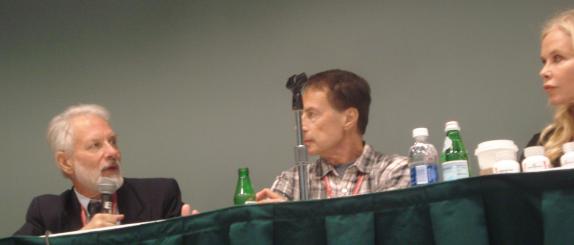

Sunday, March 3, 2013 [2:00 - 3:30] PM PST; An expert panel for a public audience of ~100
focused on human longevity and was held at the Health Freedom Expo located at the
Long Beach Convention Center. The panel was entitled "Longevity: How to Make 100 the New
50 (Stem Cells, Cytokines, and Telomeres)." This panel, led by pioneers in their field, provided
an exciting tour of the most recent discoveries in the key fields that impact how we age and
explored the very real possibility that we can STOP AGING as we now know it. The Panel was
moderated by Ms. Greta Blackburn and included, Drs. Aubrey de Grey, L. Stephen Coles, Bryant
Villeponteau, and Gregory Fahy, along with Daniel Holtz and David Kekich.
"Prof. Stephen Coles Lectures at USC"


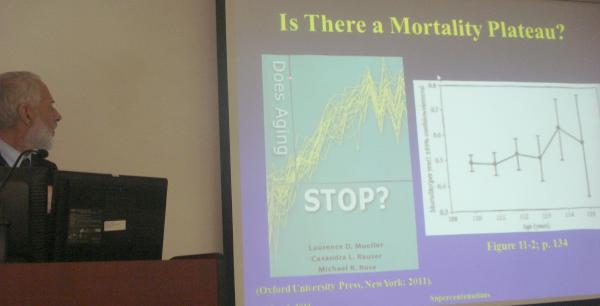

Thursday, January 31, 2013; 12:00 PM; L. Stephen Coles presented "Not My Last Lecture"
(originally "Supercentenarians: Secrets of the Oldest Old") Noontime Multidisciplinary Research
Colloquium on Aging at USC Davis School of Gerontology and the Andrus Gerontology Center
in downtown Los Angeles. Prof. Caleb E. (Tuck) Finch, Ph.D. sat in the first row.
Click for News Items from 2012.



























